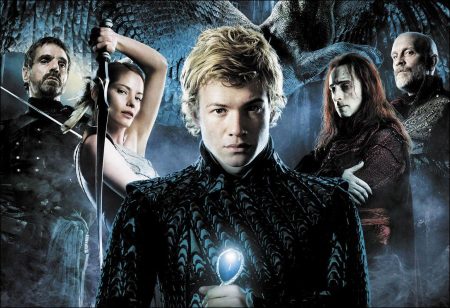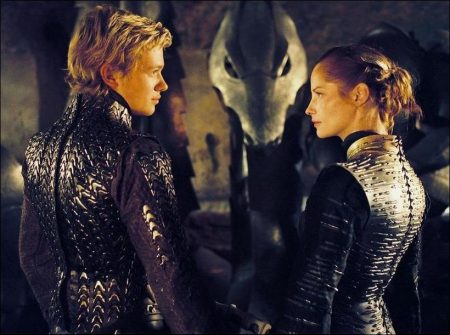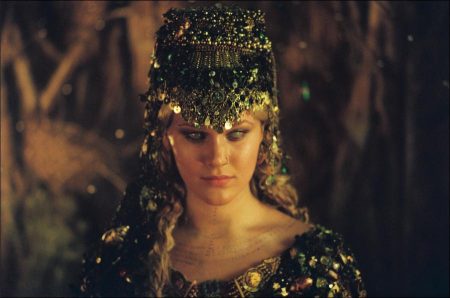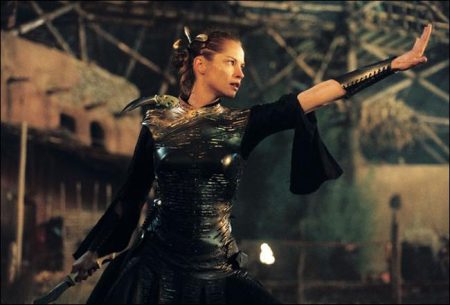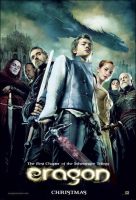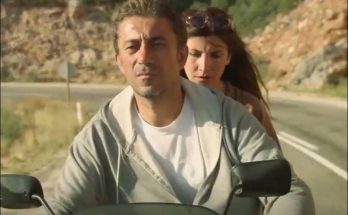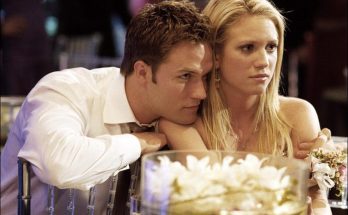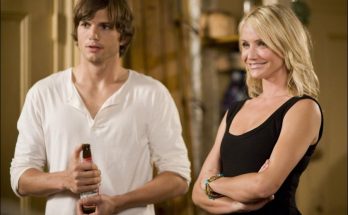Tagline: What was once your life is now your legend.
Based on the Christopher Paolini-penned bestselling fantasy novel about a youth whose discovery of a dragon egg leads him to become a knight and battle an evil king. The medieval-set tale revolves around a farm boy who learns he is the last of a breed of benevolent Dragon Riders, whose magical powers derived from bond with the beasts.
Eragon, a fantasy adventure for young people based on the phenomenally successful novel by Christopher Paolini – the first book in the young author’s epic Inheritance Trilogy – is a timeless yet modern tale. The book’s most fantastical character – a flying dragon named Saphira – arrives via the high-tech wizardry of the industry’s most honored visual effects houses: WETA Digital (the “Lord of the Rings” trilogy, “King Kong”) and Industrial Light & Magic (the “Star Wars” films, “Jurassic Park”). In addition, WETA created Eragon’s climactic and massive battle scene, in which the forces of good, led by the young Dragon Rider Eragon and Saphira, battle the armies of the evil King Galbatorix.
For over two millennia, dragons have been – depending on the culture and times – beloved, feared, or even worshipped. Today, the mythical creatures are a mainstay of pop culture. Eragon’s Saphira is inspired by the rich heritage of the storied winged creatures, but for the first time, the power of state-of-the-art computer generated imagery brings myth to photo-real, emotional life. What “Jurassic Park” was to dinosaurs, Eragon is to dragons. Indeed, Saphira is a step beyond the dinosaurs of “Jurassic Park,” as her facial imagery conveys thoughts and feelings.
Bringing Eragon to the Screen
Upon its initial release in hardcover by Knopf in August 2003, the novel Eragon became a worldwide publishing phenomenon. The book was an instant bestseller and has since spent 87 consecutive weeks on The New York Times Bestseller List, and 21 consecutive months on Publisher’s Weekly Young Adult Fiction Bestseller List, including nine months at #1. Eragon has sold 2.5 million copies in hardcover and paperback in North America alone, and the book has been published in 38 countries.
Eragon is the first novel of a trilogy. The second book, Eldest, was published in the United States and Canada in August 2005, and quickly became the number-one selling book in the United States. It has sold over one million hardcover copies, was number-one on The New York Times Children’s Best Seller list, and was a USA Today Top-50 Bestseller. It won the Young Adult / Teen 2006 Quill Book Award.
At the time of release of the Eragon motion picture, the novel Eragon held the number-one slot on The New York Times Children’s Paperback Best Seller List, and Eldest was number-one on the Times’ Children’s Hardcover Best Seller List. Sales of both books increased steadily with the release of the Eldest Limited Edition the move tie-in books – and with the help of the film’s promotional activities.
Paolini’s own story is a fantasy in itself. The first edition of Eragon was self- published by his family. The following year, Alfred A. Knopf published the novel worldwide, to huge acclaim.
Paolini, now 22, grew up in Paradise Valley, Montana – a location which inspired much of the story’s fantastic environments. His novels reflect his personal experiences growing up in a valley of the Beartooth Mountains of Montana, not unlike the valley that Eragon called home.
Screenwriter Peter Buchman, whose credits include “Jurassic Park III,” wrote the screenplay. Buchman, a fan of fantasy and science fiction literature and films, says he was “blown away” by the author’s precociousness, his mastery of plot lines and characters, and his ability to create several completely imaginary worlds. Buchman worked hard to serve the richness of Paolini’s story and characters – and the book’s legions of fans – while crafting a screenplay that would attract newcomers to the world of Eragon.
At the center of both novel and film is the bond between Eragon and Saphira. “Christopher came up with this wonderful idea of a young man who develops a bond with a dragon,” says Buchman. “That relationship is at the core of the book, and that’s what we had to translate to film.”
It was Buchman’s script that drew the attention of Stefen Fangmeier. “I found it to be an exciting read,” says the director. “With the book’s fantastical aspects, people would look at me in terms of the visual effects requirements. However, my first reaction to the material was that it was a great story that had an emotional arc.”
Eragon presents a mythology in which Dragon Riders had once brought peace and prosperity to the land of Alagaësia. Dragons gave their Riders magical powers, even immortality. No enemy could defeat them – until one of their own, Galbatorix, decided to take all the power for himself and cut down the Dragon Riders. But with Eragon’s discovery of a gleaming sapphire egg, which hatches a dragon he names Saphira, the time of the Dragon Riders has come again.
Having discovered his true path as a Dragon Rider, and with the help of his mentor Brom, Eragon is determined to bring back the golden age of justice once known throughout the land, if he can survive the machinations of King Galbatorix. Eragon is swept into a world of magic and power, becoming a true hero to – and the last hope of – the people of Alagaësia.
Taking on the title role is newcomer Ed Speleers, 18, who got the part after Twentieth Century Fox and the filmmakers conducted a worldwide casting search, which rivaled the hunt for a cinematic “Harry Potter” and included hundreds of auditions and dozens of screen tests.
The film also stars Academy Award winner Jeremy Irons as Brom, a former Dragon Rider who becomes Eragon’s mentor; Oscar® nominee John Malkovich as the powerful and evil King Galbatorix; BAFTA Award winner Robert Carlyle as the powerful sorcerer Durza; Oscar nominee Djimon Hounsou as Ajihad, the leader of the rebel Varden; Sienna Guillory as the beautiful warrior Arya; and Garrett Hedlund as a young man with a past.
Befitting Saphira’s regal bearing, one of today’s finest actors – Academy Award winner Rachel Weisz – provides the dragon’s “voice.” Weisz’s performance brings to life Christopher Paolini’s key idea for the novel: the method by which Saphira communicates with Eragon. Saphira does not speak; her lips never move as they would with a traditional CG character. Instead, the dragon connects telepathically with her Rider, which reinforces the emotional, almost spiritual bond between the two characters.
Eragon is directed by Stefen Fangmeier, one of the motion picture industry’s true visual effects geniuses. During his tenure at Industrial Light & Magic, Fangmeier supervised films such as “Saving Private Ryan,” “Twister,” “The Perfect Storm” and “Master and Commander: The Far Side of the World.” He is a three-time BAFTA Award winner, and is a four-time Oscar nominee.
For Eragon, Fangmeier’s visual effects teams employ every state-of-the-art technique to create Saphira and take the audience to the magical, timeless world of Alagaësia – not forward to a futuristic science fiction creation. Under his direction, Wolf Kroeger’s production design, Hugh Johnson’s cinematography, and Kym Barrett’s sleek costumes, give the film a contemporary edge.
The Cast
For the filmmakers, the stakes couldn’t have been higher in casting their young Dragon Rider, Eragon. Newcomer Ed Speleers emerged from the months-long, worldwide casting search. “Ed came in [to the casting session], and we just looked at each other and said, `That’s Eragon, that’s the guy from the book,'” says director Stefen Fangmeier: “I got a strong sense of Ed’s sparkle, of his life. It’s the kind of thing where you just know he’s destined to become a movie star.”
Speleers won the role as he was trying to learn his lines for a school production of “Hamlet.” He couldn’t help but be awed by this, his professional acting debut. “During production in Slovakia, we were lifted by helicopter to the top of a large mountain surrounded by incredible scenery,” he remembers. “I stood at the edge of this mountain, thinking, `What’s going on here? I’m supposed to be at school taking my exams, and I’m here having the best time of my life.’ If I continue to make movies – which I would love to do – I don’t think I will ever get that same, overwhelming feeling.”
The young actor easily grew into the role. Indeed, Speleers sees parallels between his experiences making ERAGON and his on-screen character’s journey. “I was on a new adventure, just like Eragon was,” he explains. “I had a well-structured life, doing regular things, and then I was suddenly thrown into this incredible world, starring in a movie. It’s been a great time for me to find myself (as Eragon does in the story), meet new people, and have new experiences.”
A highlight of Speleers’ experiences on Eragon was working opposite Jeremy Irons, who portrays Eragon’s mentor, Brom. The actors’ off-screen relationship mirrored what was happening on camera. “Jeremy always provided words of advice, and always nurtured me,” Speleers recalls. “He was doing so out of the kindness of his heart, but at the same time so much of Brom was in Jeremy.”
Irons says he was ready to tackle a big action-adventure picture. “Eragon reaches an audience that I haven’t reached in a while,” he says. “Equally important, Brom appealed to me; he has a wryness and fierceness, but at the same time he’s a good man.”
To prepare for the role, Irons read Eragon, and trained in the method of swordplay Paolini describes in his book. “It’s a specific style of fighting,” Irons notes. “It’s like Eastern swordplay, and is more esoteric than English medieval styles. I practiced almost every day to build the wrist strength necessary to realistically play the fighting scenes.” The many riding scenes were less of a challenge to Irons, an experienced horseman.
Brom’s and Eragon’s fates are closely tied to the evil King Galbatorix, played by Oscar-nominee John Malkovich. Galbatorix is a central character in the film, one whose presence and menace are felt even when he’s offscreen.
Although Malkovich shares no scenes with Ed Speleers, the young actor and his growing following made a distinct impression on him. “Before leaving for Budapest, a friend of mine told me that he had a bunch of kids who wanted Ed’s autograph,” he recounts. “I hadn’t experienced anything like that since working with Leonardo DiCaprio [in “The Man in the Iron Mask”].
The chief “aide” to Malkovich’s Galbatorix is Durza, a sorcerer possessed with demonic spirits. Durza is tall, handsome and pale, with red hair and maroon eyes. He is lordly in manner, but his refinement masks something unnatural.
BAFTA Award-winner Robert Carlyle, as Durza, made a strong impression on Ed Speleers. “Our first meeting was intense,” says Speleers. “Robert wore a long wig, contact lenses and full-flowing outfit. I didn’t need to get into character to react opposite Robert as Durza,” laughs Speleers. “He was Durza!”
“Robert came in very much wanting to do Eragon, and his approach to Durza was to not make the character obvious and over-the-top in his villainy,” says Wyck Godfrey. “Durza has an agenda and with his red eyes and hair, and pale skin, there are things visually apparent about the character; you don’t need to work hard to force him to be evil.”
Early in the story, Durza uses his formidable powers to try and stop the female warrior Arya, who’s on a mission to find the next Dragon Rider. “Arya has been entrusted with a dragon egg stolen from Galbatorix, carrying it across Alagaësia looking for its owner,” says Sienna Guillory, who portrays Arya. “Her warrior side uses a Zen-like fighting style. Because she’s an elf, she understands nature – the trees, light and wind – and is capable of seeing danger before it happens.
“It’s great to play a female action role that’s not all `hero’ and that’s not rough and unfeminine,” she continues. “I love horses and this was a film where I got to ride a horse and fight with a sword – brilliant!”
Guillory makes special note of the work of costume designer Kym Barrett, whom the actress says “brings a wonderful modernity and edge” to the picture. “Kym’s work reflects the timelessness of the film,” Guillory elaborates. “It’s not about being medieval or going back to another period in the past. Kym’s designs for Arya are about ecology and the environment. Arya is a kind of eco-warrior, who is in tune with nature. Everything she wears look and feels worn and soft. Kym really works amazingly well with movement.”
Arya and Eragon take a stand against Galbatorix, Durza, and their minions in the final battle of Farthen Dûr. This stronghold of the rebel Varden forces is led by Ajihad, played by Oscar nominee Djimon Hounsou. “I was attracted to ERAGON because it is an enormous adventure,” the actor explains. “Everything about it is bigger than life.”
Also taking a stand at Farthen Dûr is Murtagh, played by Garrett Hedlund, one of the few Americans in the cast. Like several of his fellow castmates, Hedlund underwent intensive physical training, including boxing and working with a long bow. But Hedlund notes that it was what’s underneath the character’s skin that intrigued him. “There’s something about Murtagh that lies under the surface,” he explains. “Murtagh has a secret and a past he’s not necessarily proud of.”
Saphira
Eragon’s distinguished cast is impressive, but the filmmakers acknowledge the picture’s “biggest” – and most expensive – star is the dragon Saphira. Christopher Paolini has said that he wanted Saphira to be “the best friend anyone could have.” In order to pull off such a character, the filmmakers realized they needed someone to completely “own” Saphira, both creatively and technically, and to serve as the point person between themselves and the facilities.
Visual Effects Supervisor Michael McAlister became that person and served, among other things, as the arbiter of the dragon. “Bringing Saphira to life was a huge undertaking that required my full attention and energies – much as a live action character requires the full attention of an actor,” says McAlister. “There were thousands and thousands of specific decisions to be made in terms of how she would look, how she would act, how she would feel, and how she would fly. I did not invent her nor decide what her character would be, but I was responsible for understanding her – inside and out – and deciding specifically how we would achieve her.”
Constant communication between the filmmakers and visual effects facilities was the key, and McAlister likened himself to the skinny part of an hourglass. “With a hopper of desire above me and an army of eager and talented artists below, I took the broad desires of the filmmakers and focused them into instructions the others could act on. A major part of my job was to make specific decisions regarding Saphira, and keep those decisions clear to all parties so that the efforts of the hundreds of artists were in constant alignment with the desires of the filmmakers.”
Under McAlister’s supervision, the artists and technicians at the renowned visual effects houses Industrial Light & Magic and WETA Digital, have created nothing less than the most dynamic, expressive dragon in motion picture history.
Samir Hoon was the ILM visual effects supervisor and Glen McIntosh was ILM’s animation director. McIntosh, who helped create the performances for Yoda and General Grievous in “Star Wars Episode III: Revenge of the Sith,” coordinated the team of ILM animators. “The tricky part in creating the performance was that Saphira was never meant to be a monster or creature,” notes McIntosh. “She is a character and one of the stars of the movie. She delivers a nuanced, layered performance.”
WETA Digital animation supervisior David Clayton, working with WETA visual effects supervisors George Murphy and Guy Williams, made additional character refinements, especially for the climactic battle scene in which Saphira becomes like a sleek and powerful jet fighter.
Saphira’s complexity of character and design stemmed from an “evolutionary” process – from the stylized artwork that adorned the book’s cover to the first movie character sketches to the final imagery we see on film. “The big question we faced,” says ILM’s Samir Hoon, “was, `How do we make a dragon that the audience has never before seen and still be consistent with Christopher Paolini’s vision of the character?’
Saphira’s design evolved as we discovered the character through the color of her wings, the size of her head, and the length of her neck. We see her emerge from the egg as being ten-inches tall. By the end of the film, she stands fifteen feet, with a wing span of 20-30 feet, length of 32 feet – and weighing about four tons.”
After many renderings and tests, the visual effects artists gave Saphira a slim, graceful look, adhering to the character’s feminine and regal qualities. “She moves and walks like a lion, with front legs almost equal in length to her back legs,” says McIntosh, who notes that he and the ILM animators spent time studying lion movement.
The design of Saphira’s wings evolved into that resembling eagle wings. But instead of the more classic look of feathers, Saphira’s wings are a combination of scales and feathers, which the ILM team dubbed “scethers.”
Saphira begins life as a hatchling, which the filmmakers endeavored to make as endearing as possible. To that end, Hoon and his team studied wildebeest cubs, lion cubs, and wolf cubs.
The Battle of Farthen Dür
Eragon has many grand set pieces, but none as big as The Battle of Farthen Dûr, where Urgals and Galbatorix’s elite army attack the Varden stronghold. The battle marks the end of Eragon’s journey and the climax of the story.
As the battle opens, Eragon and Saphira are helping fight off the king’s invading troops – leading to an aerial battle between Eragon and Durza, with Eragon atop Saphira, and Durza riding an enormous beast conjured from the dead soldiers on the ground below. The ground battle, involving hundreds of extras and stunt people captured on film during principal photography, as well as the CG extensions added during post-production, provides a backdrop for the aerial conflict – all under a dramatic moonlit sky. As the massive conflict unfolds, Farthen Dûr becomes nothing less than a vast theater of destruction.
As described in the story, the Varden stronghold is constructed in the crater of an extinct volcano. Against the cliff face are the remnants of an eroded white marble city, stoic ruins of a time past, built into the volcano wall, stretching and twisting a mile high.
Under the supervision of production designer Wolf Kroeger, the filmmakers built one of the biggest practical sets in motion picture history. The set was too spectacular to erect on a soundstage, so the production, after conducting several scouting expeditions, found an abandoned rock quarry and crater at a volcano in Hungary, near the Austria border. “That location worked out very well,” says Kroeger, since it’s written in the script that Farthen Dûr is in a volcanic area.”
Before construction could begin on this massive set, the filmmakers had to build an access road to get to the top of the crater. It took 16 weeks of planning, building and landscaping to create the set from an empty quarry into a lived-in community.
Peter MacDonald, one of the industry’s top second unit directors and action specialists – he worked on two “Superman” films, two “Batman” pictures and four “Harry Potter” blockbusters – collaborated with Stefen Fangmeier to bring the epic battle to life. “We wanted to give the sequence an edgy, combat-like feel,” notes MacDonald, a director in his own right.
To capture the action, MacDonald worked with 450 extras and stunt people, 10 hours each night – often during frigid conditions (it was winter) – for several weeks. The sequence involves Urgals (who are uncommonly tall) and elves; many of the “Urgal” extras were 6’6″ or taller, with those playing elves 5’0″ or less.
The decision to shoot at night presented challenges to director of photography Hugh Johnson. “The location was a vast area with terraces and it was very difficult to get any lights up there,” says Johnson, whose department went to elaborate lengths to rig the volcanic crater’s vast and treacherous spaces – employing a team of Russian mountaineers to haul the equipment.
For this sequence, Kym Barrett designed non-traditional costumes, this time of “armor.” “I thought of what armor would be like in this particular world,” says Barrett. “In this scene, Eragon rides Saphira and fights the invading forces, and he couldn’t be lugging around 25 pounds of armor plating. I also didn’t want the characters to look like they were wearing big, clunky suits of armor. I wanted it to be more streamlined, so I used leather for the armor.” Barrett called in noted London couture leather makers to manufacture the unique pieces.
The completion of the second unit work in Hungary marked only the first step in the scene’s creation. Fangmeier, MacDonald and crew then moved to Pinewood Studios in England, where they shot blue screen work of Ed Speleers “riding” Saphira, battling Robert Carlyle’s Durza who is astride his own flying Beast. The filmmakers wanted to push these flying scenes to get, as MacDonald says, “the most dynamic sensation possible. It’s a real roller-coaster ride.”
The actors were placed on computer-controlled rigs on hydraulics, upon which saddles were mounted. All the dragon’s movements – flying, gliding, banks-and-turns – could be experienced by Ed Speleers as Eragon. “Ed was a natural,” says MacDonald. “He loved flying, and really wanted to get things right.” Before Speleers began work on the motion rig, the filmmakers screened for him the pre-visualization footage as a reference for his “flying” maneuvers.
“ERAGON is the first film to really show the experience of flying on a dragon,” says Fangmeier. “It was a lot of fun to create the flying sequences. We were challenged to maintain a physical reality but also have an element of the fantastical. We wanted dragon riding to feel like being on a jet fighter – with lots of `Wow’ moments.”
Many of these “wow” moments were realized by New Zealand-based visual effects house WETA Digital, whose many credits include the “Lord of the Rings” trilogy, “King Kong” and “I, Robot.” For the climactic Battle of Farthen Dûr sequence, WETA worked on giving Saphira a more aggressive “performance.” “She’s taking on a more mature air at this point; she’s come of age,” says WETA visual effects supervisor George Murphy. “We gave Saphira an additional sense of command, presence and agility that would get her through the battle.”
“We developed Saphira in a physical way,” adds WETA visual effects supervisor Guy Williams. “We have lots of views of her wings that occur during the battle, which are different from those of other scenes.” Williams and Murphy also made the dragon combat-ready, with an impressive suit of armor.
In creating the lighting environments for the battle sequence, Williams and Murphy’s goal, again, was to have audiences connect with Saphira, as they would with the film’s human characters. They devised a realistic yet striking look for shots of her soaring majestically through the night – or conducting “strafing runs” on the enemy forces. “If we had relied only on light that was available, we’d have ended up with a couple of highlights of Saphira from the moon and that’s about it,” notes Murphy. “So we came up with a color palette and levels that render Saphira visible, while reinforcing the fact that this is happening at night.”
Murphy and Williams also created the fearsome creature that Durza conjures up out of the essence of the dead troops below. The Beast battles Saphira in an epic airborne duel. As described in the script, the conjured creature is a methodical killing machine bereft of fear or remorse. It is an enormous, dark, broiling cloud of smoke and ash – the face of death itself.
“Durza’s Beast provides a sharp physical contrast to Saphira’s naturalistic look,” says Williams. “The beast is a completely task-built creature – a flying mouth of teeth, oversized head and teeth, and no legs. If you combined a large tarantula with a bat, then added a bull’s head with vampire teeth, you’d have the Beast.”
“The character’s design came quickly,” adds Murphy, “but developing the technology to render it was a challenge due to the inherent difficulties in `choreographing’ smoke, and action amongst the smoke.”
WETA created effects extensions for the practical Hungary sets for the battle. “We had to master the exact terrain of the practical set so that we could match into portions of the live-action footage,” says Williams. “All our action biases more towards one side of the volcano, which is visually more interesting because we’re closer to the volcano walls and get an enhanced sense of Saphira’s flying speed.”
WETA worked on another big action sequence that combines spectacle with emotion, further exploring the connection between Eragon and Saphira, and a moving act of personal sacrifice. “We get to explore Saphira’s softer, gentler side in this scene,” says Williams. “We pushed and refined her facial animation, keeping her movements very subtle, and letting the moments work for themselves.”
In a magical moment that propels the character and story forward, WETA created a sequence in which Saphira undergoes a metamorphosis from adolescence to adulthood.
The visual effects from WETA and ILM, along with the exotic and rugged locations in Hungary and Slovakia, created the illusion of Alagaësia. Eragon was one of the biggest productions ever to be filmed in Hungary and Slovakia.
The production crew of over-500 was headquartered in the historic city of Budapest. The set for Garrow’s Farm, where Eragon lived with his Uncle Garrow and cousin Roran, was built on privately owned land in a valley at Budakesi, a forty-five minute drive from Budapest.
The production constructed Galbatorix’s lair in a hillside cave, with access available only through a hole in the cave’s roof. Special cranes were used to move equipment – including cameras, sound recorders and set dressing – into the cave. Once inside the cave, the filmmakers’ activities were limited due to the area’s status as a national monument. Later, the mountains of Slovakia would provide a number of natural settings with spectacular views across valleys, gorges and waterfalls.
These worlds and characters created by these locations, effects artists, technicians, craftsmen, filmmakers and actors stem from the imagination of Christopher Paolini, whose novel is linked to the film in an unexpected way. “I originally conceived ERAGON as a movie,” he points out. “I saw the characters and action clearly in my mind. But since I didn’t have the money to produce a film, I ended up writing the story as a book.”
At the time, it was beyond Paolini’s wildest dreams that a major studio would adapt his epic tale. But then, Paolini’s own life story, his imagination – and the journey of his heroic title character – remind us that no dream is too big.
Eragon Character Profiles
ERAGON
Eragon discovers his true path as one of the fabled Dragon Riders. With his own dragon, Saphira, and Brom as his mentor, Eragon is determined to bring back the golden age of justice once known throughout the land – if he can survive the evil machinations of Galbatorix. Eragon becomes a true hero – and the last hope for the people of Alagëisia.
BROM
One of the last of the Dragon Riders, Brom has been a disconsolate, broken man since the death of his own dragon. He has become a storyteller resigned to the rule of the evil king, but he has new hope as the mentor and father-figure to Eragon.
GALBATORIX
Galbatorix is the ruler of an enormous empire that occupies the western part of Alagaësia. The former Dragon Rider brought about the demise of the storied order, and he now rules the land with an iron fist, stopping at nothing to capture or destroy Eragon and his dragon. Galbatorix’s forces include the loathsome and brutish Urgals, whose faces are grotesquely patterned with scars.
DURZA
Durza is a Shade, a sorcerer possessed by demonic spirits. Considered one of the most powerful beings in Alagëisia, he can only be killed through the heart. As one of Galbatorix’s deadliest minions, the sorcerer is privy to palace intrigues (and possibly has dreams of power of his own).
AJIHAD
Ajihad is the leader and general of the rebel Varden. In the secret stronghold of Farthen Dûr, located in a volcanic crater in the Beor Mountains, Ajihad and the Varden plot to overthrow Galbatorix.
ARYA
As the guardian of the dragon egg, the beautiful warrior Arya is willing to die to protect the line of dragons. She joins Eragon, Saphira, and the rebellious Varden in a desperate stand against the forces of Galbatorix.
MURTAGH
Murtagh is the son of Morzan, who betrayed the Dragon Riders to Galbatorix. Desperate to expunge the guilt of his father’s sin, Murtagh seeks refuge in battle, fighting for the forces of good.
SAPHIRA
The story’s most fantastical character is the flying dragon Saphira, who connects telepathically with her Rider, Eragon. As Saphira soars majestically through the sky – or conducts “strafing runs” on enemy forces – audiences will experience the most dynamic, fierce dragon ever, in the ultimate dragon movie.
Eragon Glossary
Alagaësia: a kingdom stretching from the western coastal wilderness of the Spine into the inland Hadarac desert, which spreads to the southern summits of the Beor Mountains. It is a world of humans, sorcerers, monsters – and mighty dragons.
The Ancient Language: a form of communication that enables certain people to use magic.
Beor Mountains: a huge mountain range in the southeast of Alagaësia, where the Varden make their home.
Carvahall: Eragon’s hometown; a small town near the Spine.
Dragon Riders: those who help maintain peace in Alagaësia with the help of their dragons .
Gil’ead: a heavily guarded city where Arya is imprisoned by Durza.
Ra’zac: demonic mercenaries that serve Durza.
Shade: a sorcerer possessed by evil spirits.
Spine, The: Vast mountain range covering almost all of Alagaësia’s west coast.
Urgals: loathsome and brutish troops who serve Galbatorix. Their faces are grotesquely patterned with scars.
Varden: a group of rebels based in Farthen Dûr.
Zar’roc: Eragon’s sword, given to him by Brom.
Eragon (2006)
Directed by: Stefen Fangmeier
Starring: Ed Speleers, John Malkovich, Jeremy Irons, Djimon Hounsou, Robert Carlyle, Sienna Guillory, Joss Stone, Rachel Weisz, Christopher Egan, Garrett Hedlund
Screenplay by: Peter Buchman
Production Design by: Wolf Kroeger
Cinematography by: Hugh Johnson
Film Editing by: Roger Barton, Masahiro Hirakubo, Chris Lebenzon
Costume Design by: Kym Barrett
Set Decoration by: Elli Griff, Sandy Walker, Simon Wakefield
Art Direction by: Michael Diner, Jonathan Hely-Hutchinson, Helen Jarvis, Stuart Kearns, Tibor Lázár, Stuart Rose
Music by: Patrick Doyle
MPAA Rating: PG for fantasy violence, intense battle sequences and some frightening images.
Distributed by: 20th Century Fox
Release: December 15, 2006
Visits: 67
